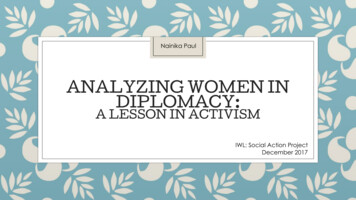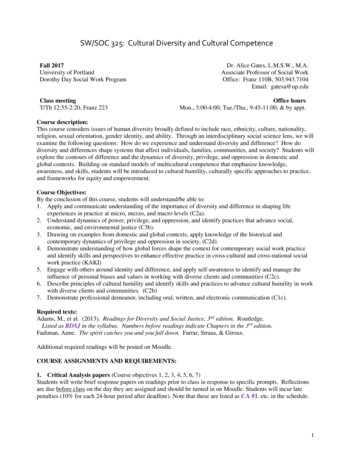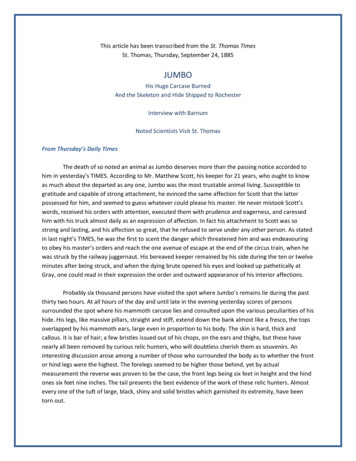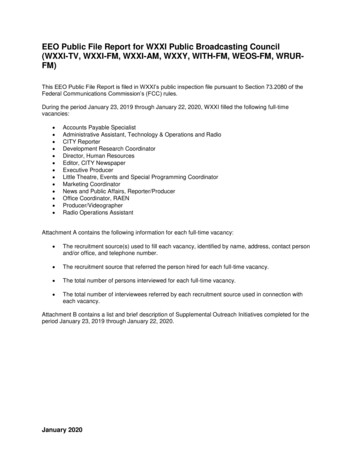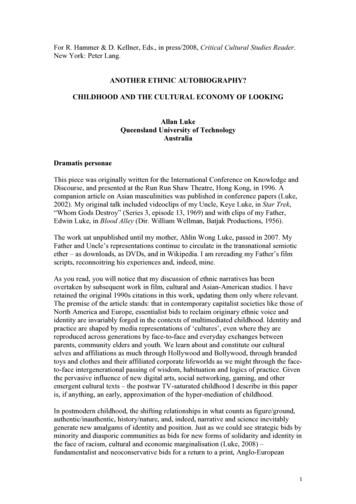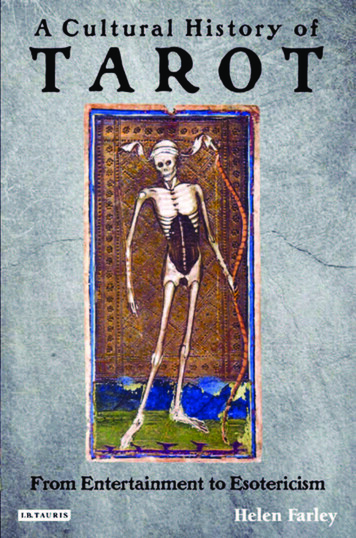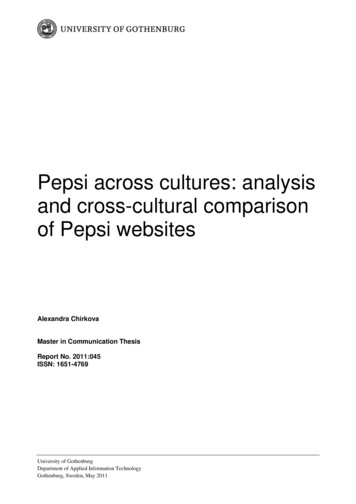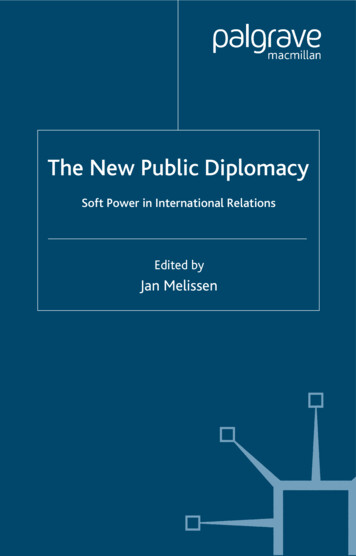
Transcription
The New Public DiplomacySoft Power in International RelationsEdited byJan Melissen
Studies in Diplomacy and International RelationsGeneral Editors: Donna Lee, Senior Lecturer in International Organisationsand International Political Economy, University of Birmingham, UK andPaul Sharp, Professor of Political Science and Director of the Alworth Institutefor International Studies at the University of Minnesota, Duluth, USAThe series was launched as Studies in Diplomacy in 1994 under the generaleditorship of G. R. Berridge. Its purpose is to encourage original scholarship on allaspects of the theory and practice of diplomacy. The new editors assumed theirduties in 2003 with a mandate to maintain this focus while also publishingresearch which demonstrates the importance of diplomacy to contemporaryinternational relations more broadly conceived.Titles include:G. R. Berridge (editor)DIPLOMATIC CLASSICSSelected Texts from Commynes to VattelG. R. Berridge, Maurice Keens-Soper and T. G. OtteDIPLOMATIC THEORY FROM MACHIAVELLI TO KISSINGERHerman J. CohenINTERVENING IN AFRICASuperpower Peacemaking in a Troubled ContinentAndrew F. Cooper (editor)NICHE DIPLOMACYMiddle Powers after the Cold WarDavid H. Dunn (editor)DIPLOMACY AT THE HIGHEST LEVELThe Evolution of International SummitryBrian Hocking (editor)FOREIGN MINISTRIESChange and AdaptationBrian Hocking and David Spence (editors)FOREIGN MINISTRIES IN THE EUROPEAN UNIONIntegrating DiplomatsMichael HughesDIPLOMACY BEFORE THE RUSSIAN REVOLUTIONBritain, Russia and the Old Diplomacy, 1894–1917Gaynor JohnsonTHE BERLIN EMBASSY OF LORD D’ABERNON, 1920–1926Christer Jönsson and Martin HallESSENCE OF DIPLOMACY
Donna LeeMIDDLE POWERS AND COMMERCIAL DIPLOMACYBritish Influence at the Kennedy Trade RoundMario LiveraniINTERNATIONAL RELATIONS IN THE ANCIENT NEAR EAST, 1600–1100 BCJan Melissen (editor)INNOVATION IN DIPLOMATIC PRACTICETHE NEW PUBLIC DIPLOMACYSoft Power in International RelationsPeter NevilleAPPEASING HITLERThe Diplomacy of Sir Nevile Henderson, 1937–39M. J. PetersonRECOGNITION OF GOVERNMENTSLegal Doctrine and State Practice, 1815–1995Gary D. RawnsleyRADIO DIPLOMACY AND PROPAGANDAThe BBC and VOA in International Politics, 1956–64TAIWAN’S INFORMAL DIPLOMACY AND PROPAGANDARonald A. WalkerMULTILATERAL CONFERENCESPurposeful International NegotiationA. Nuri Yurdusev (editor)OTTOMAN DIPLOMACYConventional or Unconventional?Studies in Diplomacy and International RelationsSeries Standing Order ISBN 0–333–71495–4(outside North America only)You can receive future titles in this series as they are published by placing astanding order. Please contact your bookseller or, in case of difficulty, write to usat the address below with your name and address, the title of the series and theISBN quoted above.Customer Services Department, Macmillan Distribution Ltd, Houndmills,Basingstoke, Hampshire RG21 6XS, England
The New Public DiplomacySoft Power in International RelationsEdited byJan MelissenDirector Clingendael Diplomatic Studies ProgrammeNetherlands Institute of International Relations, Clingendael
Editorial matter, selection and introduction Jan Melissen 2005Chapters their authors 2005All rights reserved. No reproduction, copy or transmission of thispublication may be made without written permission.No paragraph of this publication may be reproduced, copied or transmittedsave with written permission or in accordance with the provisions of theCopyright, Designs and Patents Act 1988, or under the terms of any licencepermitting limited copying issued by the Copyright Licensing Agency,90 Tottenham Court Road, London W1T 4LP.Any person who does any unauthorised act in relation to this publicationmay be liable to criminal prosecution and civil claims for damages.The authors have asserted their rights to be identifiedas the authors of this work in accordance with the Copyright,Designs and Patents Act 1988.First published 2005 byPALGRAVE MACMILLANHoundmills, Basingstoke, Hampshire RG21 6XS and175 Fifth Avenue, New York, N.Y. 10010Companies and representatives throughout the worldPALGRAVE MACMILLAN is the global academic imprint of the PalgraveMacmillan division of St. Martin’s Press, LLC and of Palgrave Macmillan Ltd.Macmillan is a registered trademark in the United States, United Kingdomand other countries. Palgrave is a registered trademark in the EuropeanUnion and other countries.ISBN-13: 978–1–4039–4516–7 hardbackISBN-10: 1–4039–4516–0 hardbackThis book is printed on paper suitable for recycling and made from fullymanaged and sustained forest sources.A catalogue record for this book is available from the British Library.Library of Congress Cataloging-in-Publication DataThe new public diplomacy : soft power in international relations / edited byJan Melissen.p. cm.Includes bibliographical references and index.ISBN 1–4039–4516–0 (alk. paper)1. International relations. 2. Diplomacy. I. Melissen, Jan.JZ1305.N47 08307206105Printed and bound in Great Britain byAntony Rowe Ltd, Chippenham and Eastbourne
For Isabel, Eugenia and Daniel
This page intentionally left blank
ContentsxiNotes on ContributorsAcknowledgementsxviiIntroductionJan MelissenxixPart I: The New Environment1. The New Public Diplomacy: Between Theory and PracticeJan MelissenIntroductionBeyond American public diplomacy?Defining the new public diplomacyPublic diplomacy and related conceptsConclusion: diplomacy and the ordinary individual2. Rethinking the ‘New’ Public DiplomacyBrian HockingIntroductionUnpicking the threads of public diplomacyPublic diplomacy and power: hard, soft and stickyPublic diplomacy: hierarchies and networksPublic diplomacy and diplomatsConclusion33611162328282933353941Part II: Shifting Perspectives3. Power, Public Diplomacy, and the Pax AmericanaPeter van HamIntroduction: an American Empire by default?Soft power, hard power, and the ‘indispensable nation’Public diplomacy: wielding soft powerThe limits of PR and spindoctoringConclusion: a tough sell for liberal imperialismvii474749565963
viiiContents4. Niche Diplomacy in the World Public Arena: the Global‘Corners’ of Canada and NorwayAlan K. HenriksonIntroductionThe power of ‘the better argument’‘Niche diplomacy’ in the public arenaSoft power and political strategiesCanada: risks and rewards of open confrontationNorway: a parallel and still independent courseConclusion: lessons from northern corners?5. Public Diplomacy in the People’s Republic of ChinaIngrid d’HoogheIntroductionChina’s foreign policy and diplomacyTargeting foreign audiences from 1949 onwardsChina’s present public diplomacy goalsAssets and liabilitiesTarget groupsThe instrumentsThe inner working of China’s publicdiplomacy systemChina’s public diplomacy strategies: the case of TibetThe limits of China’s public diplomacyConclusion6. Revolutionary States, Outlaw Regimes and theTechniques of Public DiplomacyPaul SharpThe public diplomacy of the Bolsheviks andthe Berne missionThe public diplomacy of Qaddafi’s Libyan JamahiriyaIranian public diplomacy under KhomeiniConclusions: public diplomacy and the ‘war on terror’7. The EU as a Soft Power: the Force of PersuasionAnna MichalskiIntroductionScope of 3106107110114117124124125
Contents ixExternal policy and normative powerThe internal dimension of EU communicationand informationEU external communicationThe evolving European foreign policy andthe significance of communicationConclusion126127130139141Part III: Improving Practice8. Culture Communicates: US Diplomacy That WorksCynthia P. SchneiderIntroductionAmerican culture and understanding Americauntil the Cold WarDiplomacy that worked: cultural diplomacyduring the Cold WarThe role(s) and position(s) of cultural diplomacy in theUS government or ‘déjà vu all over again’Comparative practices of other countriesCultural diplomacy in the twenty-first centuryThe challenges of cultural diplomacy todayConclusion9. Making a National BrandWally OlinsIntroductionFrance and nation-brandingProjecting the national brandConclusion10. Dialogue-based Public Diplomacy: a New ForeignPolicy Paradigm?Shaun RiordanIntroductionBuilding bridges to moderate IslamPromoting civil societyBeyond selling policies, values, and national imageCollaboration with non-governmental agentsPractitioners as public diplomacy 72177180180180184186190193
xContents11. Training for Public Diplomacy: an EvolutionaryPerspectiveJohn HemeryIntroduction: training in transitionBarriers to trainingChanging attitudes: flexible approachesFormal public diplomacy trainingPublic diplomacy as a professionThe way forward for training?Designing the perfect 10
Notes on ContributorsPeter van Ham is Director of Global Governance Research at theNetherlands Institute of International Relations ‘Clingendael’ in TheHague, and Professor at the College of Europe in Bruges. He holds adoctorate in Political Science (International Relations) from theuniversity of Leiden. He was Professor of West European Politics atthe George C. Marshall European Center for Security Studies inGarmisch-Partenkirchen (1996–2001); a senior research fellow at theWEU Institute for Security Studies in Paris (1993–96); and has been avisiting scholar at Columbia University (New York), the Royal Instituteof International Affairs (London), and the Copenhagen Peace ResearchInstitute (COPRI). His books include: Mapping European Security afterKosovo (2002); European Integration and the Postmodern Condition (2001);and A Critical Approach to European Security (1999). He has publishedin Foreign Affairs, The National Interest, Millennium, Security Dialogue andother academic journals.John Hemery is the founder and Director of the Centre for Political andDiplomatic Studies. He was educated at Dartmouth College in theUnited States, and was a postgraduate at both Oxford and Cambridge.After 18 years teaching politics and international relations he developedthe UK Foreign and Commonwealth Office’s programme of diplomatictraining for the new governments of Central and Eastern Europeemerging after 1989. Since then he has designed and directed morethan 60 specialist courses for politicians, officials and civil societyorganizations in 40 countries. These programmes have included one- andtwo-week courses of training in public diplomacy conducted at WiltonPark in the UK and also abroad. The Centre for Political and DiplomaticStudies is currently developing a new programme of training for publicdiplomacy that addresses both strategy and professional practice.Alan K. Henrikson is Director of the Fletcher Roundtable on a NewWorld Order, Fletcher School of Law and Diplomacy, Tufts University.During spring 2003 he was Fulbright/Diplomatic Academy VisitingProfessor of International Relations at the Diplomatische Akademie inVienna. At the Weatherhead Center for International Affairs at HarvardUniversity he has been an Associate and Visiting Scholar and has servedxi
xiiNotes on Contributorsas Counselor on Canadian Affairs. He received AB, AM, and Ph.D. degreesin History from Harvard University where he was a Harvard NationalScholar and a Danforth Graduate Fellow. He also holds BA and MA degreesfrom the University of Oxford. He has written widely on US foreignpolicy, US–European Union relations, the security of the Nordic/Arcticarea, Canadian–US–Mexican continental integration, and multilateraldiplomacy and the UN system. Among his recent publications are: ‘TheGeography of Diplomacy’ in The Geography of War and Peace (2005); and‘Good Neighbour Diplomacy Revisited’ in Holding the Line: Borders in aGlobal World (2005).Brian Hocking is Professor of International Relations and Director ofthe Centre for the Study of Foreign Policy and Diplomacy at CoventryUniversity in the UK. He graduated from the Universities of Bristol andLeicester and received his Ph.D. from the University of London. Beforetaking up his post in Coventry in 1978, he lectured at the University ofTasmania and was affiliated to the Institute of Commonwealth Studiesin London. He is the author of many articles and has written and editedten books on international relations, trade politics and diplomacy. Amonghis recent books are: Trade Politics (2004, co-editor and contributor withS. M. McGuire); Integrating Diplomats? Foreign Ministries in the EuropeanUnion (2002, editor and contributor with D. Spence); Trade Politics:Domestic International and Regional Perspectives (1999, contributor andeditor with S. M. McGuire); and Foreign Ministries: Change and Adaptation(1999, editor and contributor).Ingrid d’Hooghe is a research associate with the Clingendael DiplomaticStudies Programme at the Netherlands Institute of InternationalRelations ‘Clingendael’ in The Hague. She holds an MA degree inSinology from Leiden University and studied at Fudan University inShanghai. Her career began at the Netherlands Embassy in Beijing in1989 and in 1991 she returned to Leiden when she joined the Researchand Documentation Centre for Contemporary China at the SinologicalInstitute. After three years in Geneva (1994–97) she once again joinedthe Sinological Institute in Leiden, before moving to Clingendael in2001. She has published on various Chinese domestic and foreignissues, and her current research focuses primarily on China’s foreignpolicy and diplomacy. She has recently written on China’s relationshipwith North Korea, Chinese–ASEM relations, and the effects of ‘9/11’ onChina’s foreign policy. She co-edited China’s Legal Developments andTheir Political Limits (with Eduard Vermeer 2001).
Notes on ContributorsxiiiJan Melissen is Director of the Clingendael Diplomatic Studies Programmeat the Netherlands Institute of International Relations ‘Clingendael’,The Hague. He is also part-time Professor in the Department of Politics,Antwerp University. He graduated from the University of Amsterdamand received his doctorate at the University of Groningen. Beforejoining Clingendael in 2001, he worked in British academe and wasDirector of the Centre for the Study of Diplomacy at the University ofLeicester (UK). Jan Melissen is presently working on a project on trendsin diplomatic representation. He is co-editor of The Hague Journal ofDiplomacy and managing editor of the Discussion Papers in Diplomacy. Hehas written many articles in English and in Dutch. His previous booksare: The Struggle for Nuclear Partnership (1993); Innovation in DiplomaticPractice (1999); Diplomatie: Raderwerk van de internationale politiek (1999);and Europese diplomatie (2000).Anna Michalski is a Senior Research Fellow at the Netherlands Instituteof International Relations ‘Clingendael’. She completed her Ph.D. thesisat the London School of Economics and Political Science and heldresearch positions at the Royal Institute of International Affairs and theCentre d’Etudes et de Recherches Internationales in Paris. Between 1996 and2001 she worked at the European Commission’s Forward Studies Unit.She was also a leading member of the Forward Studies Group’s Scenariosteam. At Clingendael Anna Michalski focuses on the role of the EuropeanCommission, the European Convention, the future of EU governanceand the Lisbon Process. Recent publications include: The Lisbon Process(2004); The Political Dynamics of Constitutional Reform (2004, editor);European Convention on the Future of Europe (2003, with Matthias Heise);Governing Europe (2002); European Futures (2000, with Gilles Bertrandand Lucio R. Pench).Wally Olins CBE is a co-founder of Wolff Olins, of which he wasChairman until 1997. He is now Chairman of Saffron Brand Consultants.He was awarded a CBE in 1999, was nominated for the Prince PhilipDesigners Prize in 1999, received the Royal Society of Arts’ BicentenaryMedal for his contribution to design and marketing in 2000, andreceived the D&AD President’s Award in 2003. He has advised many ofthe world’s leading organizations, and he has worked in the publicsector and with a number of countries. Wally Olins has written severalbooks including Corporate Identity. His publications include TradingIdentities (1999) and Wally Olins On Brand (2003). Wally Olins is one of
xivNotes on Contributorsthe world’s most experienced practitioners of corporate identity andbranding. He has a particular interest in and experience of the brandingof regions and nations. He was educated at Oxford and is currentlyVisiting Fellow at Said Business School in Oxford and at LancasterUniversity and Copenhagen Business School.Shaun Riordan was educated at Cambridge, where he received an MA(Hons) in Philosophy. He entered HM Diplomatic Service in 1984. Inhis early diplomatic career he was posted to the UK’s mission to the UN,New York, and the British Embassy in Beijing. At the FCO he worked inthe United Nations Department and as Head of the Middle EasternSection’s Security Coordination Department and as Head of the PolicySection of the Eastern Adriatic Unit. In 1995 he became Head of thePolitical Section at the British Embassy in Madrid. In 2000 he resignedfrom the Diplomatic Service, and is now Director of ZEIA SL, a Madridbased consultancy service. In 2002 he was Visiting Research Fellow atthe Centre for the Study of Global Governance, London School ofEconomics. He is author of The New Diplomacy (2003), contributed toMonarchies (Demos, 2002), and contributes regularly to the Spanishprint and electronic media, as well as being a commentator for the BBCon terrorism and Spanish politics.Cynthia P. Schneider is Director of the Life Science and Society Initiativeand Distinguished Professor of Diplomacy at Georgetown University.She was US Ambassador to the Netherlands (1998–2001), and wasawarded the Office of the Secretary of Defense’s Exceptional PublicService Order, the highest civilian award given by the US Department ofDefense. For 2004–06 she has been named Pfizer Medical HumanitiesInitiative Scholar in Residence. In addition, she is working on a projecton ‘best practices’ in public–private partnerships to bring agriculturalbiotechnology to the developing world. Ambassador Schneider is a nonresident Fellow at the Brookings Institution and the Institute for theStudy of Diplomacy. She is a Supervisory Board member of Royal Ahold,and of the Board of the Institute of Europe at Columbia University, theInstitute for Cultural Diplomacy, and of the Anne Frank FoundationAmerican Board. She has published on cultural diplomacy, bioterrorismand biopreparedness, on Rembrandt and seventeenth-century Dutch art.Paul Sharp is Professor and Head of Political Science at the Universityof Minnesota, Duluth. He is also founding chair of both the DiplomaticStudies Section and the English School Section of the International
Notes on ContributorsxvStudies Association (ISA). He is a member of the ISA’s GoverningCouncil and Executive Committee. He has recently held visitingfellowships at the University of Malta and the University of Cambridge.His most recent publications include: ‘Virtue Unrestrained: HerbertButterfield and the Problem of American Power’, in International StudiesPerspectives (2004); ‘Mullah Zaeef and Taliban Diplomacy’, Review ofInternational Studies (2003); and ‘Herbert Butterfield, the English School,and the Civilizing Virtues of Diplomacy’, International Affairs (2003). Heis currently undertaking research for a book on Outlaw Diplomacy and astudy of the diplomacy of American Indian tribes in the upper Midwest.
This page intentionally left blank
AcknowledgementsEditing collective books takes time and it is a well-known fact that theyparticularly require patience from conscientious and punctual contributorswho hand in their chapter before the editor’s (first) deadline. I amparticularly grateful to the contributors to this volume whose patiencewas tested by the inevitable delays that seem to accompany a collaborativescholarly effort.Editing books is, however, also great fun. The early stages of such ajoint venture with colleagues from various countries first of all offer anexcellent excuse for a stimulating international conference, and in theprocess of making a book one often gets to know people with whom itis a pleasure to work. The group of authors contributing to this bookhas expanded my intellectual horizon and understanding of publicdiplomacy considerably. Our contacts via email, at the NetherlandsInstitute of International Relations ‘Clingendael’ in The Hague, andsubsequently at academic gatherings in other places, have resulted in agreater circle of friends and colleagues in diplomatic studies.I am indebted to numerous diplomats who kindly shared their viewsand personal experiences with me, and I am also grateful for thesupport received from colleagues at the Clingendael Institute, where thestudy of diplomacy is now prioritized alongside diplomatic training forcountries from many corners of the world. Time cannot be beaten whenmaking an edited book, but distance is fortunately irrelevant. RebeccaSolheim, who is based in Sweden, went through all of the texts meticulously and from start to finish has turned out to be a fantastic copyeditor. I can only hope that we continue to work together on futureprojects. I am also indebted to Ashvin Gonesh, who compiled the indexto this book. Finally, Isabel, Eugenia and Daniel have been enormouslysupportive. I owe them a lot for putting up with me: the man in thefamily who was not always there to be a family man.xvii
This page intentionally left blank
IntroductionJan MelissenThe idea to create this book was triggered by the feeling that the debateabout public diplomacy after September 2001 had mainly taken placein the press and that the time was ripe for students of diplomacy to lookat this phenomenon.In the early stages of the book it became clear how much confusionstill surrounded public diplomacy (that is, the relationship betweendiplomats and the foreign publics with whom they work) with publicdebate on the concept being particularly intense in the United States.Between ‘9/11’ and the outbreak of war in Iraq, public diplomacy wasbeyond any doubt the hottest item in the US foreign policy establishment. Most American think tanks produced advisory reports on publicdiplomacy, some of them more helpful than others, but so far there hasbeen remarkably little academic literature on post-Cold War publicdiplomacy. Those interested in it are confronted with an overload ofpress coverage, comment and analysis as well as instant advice forpolicy-makers. What is missing, however, is a lack of analysis ofdeeper trends, and a perspective on how official communicationwith foreign publics should be seen in the context of wider diplomaticpractice.There are, of course, many ways to look at public diplomacy, andstudents of diplomacy are fortunately by no means the only academicsinterested in it. It seems probable that the vantage point of students ofglobal communication, historians of propaganda or international relations’ theorists leads to views on public diplomacy that differ fromthose of students of diplomacy. In this book the practice of diplomacyis the starting point for the majority of the contributions. Most authorsbelieve that public diplomacy can be better understood in the contextof broader changes in diplomatic practice and that public diplomacycan at least partly be seen as a symptom of change in the conduct ofinternational relations. In a broader historical perspective it may evenbe ventured that – for better or for worse – the practice of foreign ministriesand embassies in engaging with civil society groups and individualsabroad demonstrates that the evolution of diplomatic representationhas reached a new stage. The truth is that foreign publics now matter topractitioners of diplomacy in a way that was unthinkable as little asxix
xxIntroduction25 years ago. In some of the more pioneering countries in this field, onecan clearly observe that public diplomacy is gradually moving awayfrom the periphery of diplomatic work. The same has happened tocommercial diplomacy – that is, activities by foreign ministries andembassies in support of their country’s business and finance sectors –or, at least in Western countries, to consular relations and in particularthe effort put into looking after the well-being of a country’s ownnationals abroad. Many practitioners in the world’s diplomatic servicesmay not yet have grasped the significance of communication withforeign publics, but it is a telling sign that in a considerable number ofcountries it has captured the firm attention of senior management inforeign ministries as well as the political leadership.It is worth looking at public diplomacy beyond the experiences of theUnited States or the anglophone world. The debate about the newpublic diplomacy after 11 September 2001 has become dominated byUS public diplomacy, and it has been characterized by a strongemphasis on international security and the relationship between theWest and the Islamic world. The US experience should, however, notdistract from the observation that many countries became interested inpublic diplomacy long before ‘9/11’, and for very different reasons. Inorder to understand public diplomacy properly, it is equally interestingto look at big, medium-sized, small and even micro-states, and also toanalyse the way in which non-democratic countries explore this newform of ‘outreach’ in foreign relations. The strong emphasis in theUnited States on homeland security, the ‘war on terror’ and ‘winninghearts and minds’ in the Islamic world does not mirror the concernsand interests in public diplomacy that are articulated in many othercountries. To be sure, September 2001 was an important trigger for thepresent debate on public diplomacy throughout the global diplomaticcommunity, but for many countries it was not the beginning, nor didthe US experience set the terms for thinking on this issue outside NorthAmerica. This volume is a first attempt to lift the veil on a range ofapproaches towards public diplomacy. After all, for those who are interested in diplomatic practice, the public diplomacy of the government ofKyrgyzstan is potentially as interesting as the way in which the US StateDepartment is addressing the challenge of communicating with publicsoverseas.This book is meant for students of diplomacy and for diplomats. Animportant driver for some authors is their intellectual curiosity anddesire to understand public diplomacy; others tend to blend academicanalysis with recommendations for practitioners; and a third category of
Introductionxxiauthors is primarily motivated by the idea that a proper understandingof public diplomacy can contribute to better diplomatic practice andcan help to prevent practitioners from misunderstanding its requirements. The book was deliberately conceived as a collective effort byauthors from different countries and with varying professional backgrounds. They currently live in the United States, the United Kingdom,the Netherlands or Spain, and are not just academics, but also scholardiplomats, and consultants or trainers in diplomacy. They are first of alltrying to come to grips with public diplomacy from a set of differentthematic and national angles, although the book is not designed as astraightforward comparison between different countries. Second, thisbook looks at public diplomacy as it is practised by different types ofcountries and by the European Union as an increasingly autonomouslyoperating international organization. Third, the book tries to clarifyhow practitioners can be more effective as ‘public diplomats’. It doesnot, however, constitute an exercise in school building, nor does it tryto force its authors into any form of academic straitjacket. On thecontrary, the close reader will not fail to notice that the authors disagree on a number of fundamental points. The book’s relatively modestaim is therefore to reflect on public diplomacy today, to assess itsimportance in the conduct of international relations and, by doing so,to contribute to a wider academic debate on recent trends in diplomacy.The study of public diplomacy is bound to lead to disappointing resultsif it is dissociated from a broader understanding of diplomaticpractice, and students of diplomacy who ignore public diplomacy dolittle justice to a fundamental aspect of diplomacy’s contemporaryevolution.In the first part of this book, Jan Melissen’s introductory chapter onthe new public diplomacy and Brian Hocking’s theoretical reflectionson the subject first of all aim at conceptual clarification. They evaluatethe new public diplomacy’s importance in the present internationalenvironment. Both authors consider the new public diplomacy as partof the fabric of world politics, although some of their conclusions on itssignificance are fundamentally different. Melissen introduces the newpublic diplomacy as a concept and assesses current developments inthis field. His analysis identifies characteristics of good practice and itdistinguishes between on the one hand propaganda, nation-brandingand cultural relations, and on the other hand public diplomacy. Hockingcontinues to unpick the various threads of which public diplomacy iscomposed, re-examines the ‘soft power’ argument that often surfaces inrelation to the discussion on public diplomacy, and contrasts public
xxiiIntroductiondiplomacy in a hierarchic state-centric image of international relationswith a network model.In the second part of the book, five authors show some of the diversitydisplayed in the practice of public diplomacy across the world. Theylook at radically different types of countries and one internationalorganization: the world’s leading superpower; two democratic middlepowers; an authoritarian great power; revolutionary public diplomacyand communication with foreign audiences by rogue st
Studies is currently developing a new programme of training for public diplomacy that addresses both strategy and professional practice. Alan K. Henrikson is Director of the Fletcher Roundtable on a New World Order, Fletcher School of Law and Diplomacy, Tufts University. During
